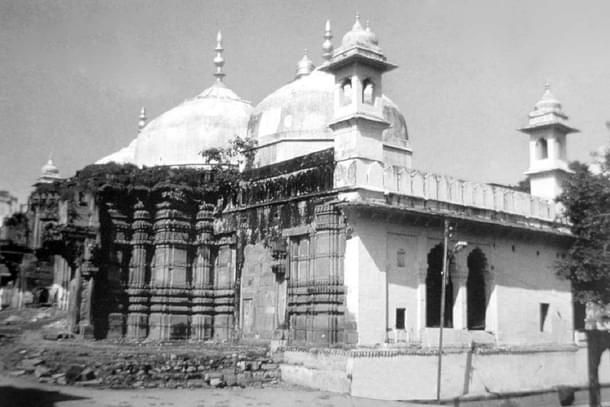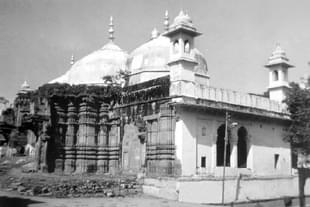Ideas
The Places Of Worship Act: A Historical Wrong
Aaina
May 21, 2022, 06:34 PM | Updated 06:46 PM IST
Save & read from anywhere!
Bookmark stories for easy access on any device or the Swarajya app.


A lot has been said about the contents of the Places of Worship Act in the wake of a court-mandated survey and videography conducted inside Gyanvapi mosque. The Act provides for the maintenance of the religious character of any place of worship as it existed on 15 August 1947. However, a look at history throws questions on the need for such a law in the first place.
Every law made in the Parliament, after much deliberation, hopes to solve a problem. But the Place of Worship Act, instead of solving a problem, was creating grounds for enmity between Hindus and Muslims. As Uma Bharti, BJP MP, while opposing the ill-intentioned Places of Worship Act in the Parliament, explained:
Owners of bullock carts in villages, create a wound on the back of the ox and when they want their bullock-carts to move faster they strike at the wound. Similarly, these disputes are wounds and marks of slavery on our 'Bharat Mata'. So long as 'Gyan Vapi' continues in its present condition at Banaras and a grave remains in a temple at Pavagarh, it will remind us of the atrocities perpetrated by Aurangzeb including his efforts to convert Hindus to Islam and this would be very painful.”
She asserted that peace cannot be ensured by simply dismissing the sentiments of the Hindu devotees. The Act implied that for the sake of reconciliation, Hindus should forsake their religious places, which were once ransacked to humiliate their ancestors and dismember cultural continuity, for eternity. The gesture towards reconciliation, as per the Act, was one-sided since it was the Hindus who were the victims of Islamic aggression than the other way round.
The Act failed to answer how reconciliation can take place when Hindus can see their symbols of faith being run down by the other community as they pay obeisance before their Gods?
Ram Janambhoomi was kept out of the Act since the matter was considered sub-judice. But for temples such as Gyanvapi-Shringar Gauri Complex in Varanasi and Krishna Janambhoomi in Mathura, the Act sealed their destiny to the relics of a colonial past.
This timing of the Act is indicative of the intention behind it. It was passed in the Parliament during a heightened Ram Janambhoomi movement and a momentous rise of the Bhartiya Janata Party from two seats in 1984 to 120 seats in the 1991 general elections.
During the discussion in Lok Sabha, the jitteriness among the Congress-led coalition government witnessing Hindu mobilisation and assertion across caste and regional fault lines was evident. Most of the speakers, speaking in favour of the Bill warned about the perils of a rising BJP and considered the Bill to be a security against its further expansion.
During the debate on the Places of Worship Bill, P M Sayeed, an MP warned of the ill effects of mixing politics with religion. He belonged to the grand old party, which had overturned the Supreme Court’s decision in the Shah-Bano case, pandering to the fanatics within the Muslim fold.
But he was apprehensive of BJP taking on a rath yatra in support of rebuilding a grand temple at Lord Ram’s birthplace. He said that BJP, riding on the success of becoming a 120+ seat party, thinks that it could come to power by supporting temple reconstruction at Ram Janambhoomi. Surely, his concerns were more about the BJP coming to power than anything else.
Congress MP Mani Shankar Aiyar, in his address, started with ridiculing BJP’s Uma Bharati for her lack of English-speaking skills and then went on to call the Act of building a mosque by demolishing Visheshvara's Temple in Kashi, ‘a symbol of secularism’.
He added “When I come across a temple and a mosque together, then I feel that it is a secular country”, again brushing over the fact that how did the temple and mosque come together in the first place. It was not through an act of mutual discussion but through brutal suppression of Hindu belief system by Islamic marauders.
He proudly mentioned that he represents a constituency where one out of every six voters is a Muslim, indicating that his line of argument arises from him pandering to his vote bank. In the end, he warned of a saffron wave in the form of 117 (BJP) MPs and appealed to fellow “secular” forces to come together and fight communal forces.
Another Congress MP, Bh. Vijaya Kumar Raju, wondered, “In the name of religion BJP wanted to grab the power at the centre. But invoking Lord Rama's name, by flaring up the Hindu sentiment, they somehow wanted to come to power. In 1984, they had only two seats in Lok Sabha. If not for the religion how could they bag so many seats in 1989 elections?”
Ghulam Nabi Azad of Congress stated the true intention of bringing such a bill. He said, “the time has come when through this Bill we can impose some check on some political parties which adopt the religion as a mean to win the Election be it a Lok Sabha or Legislative Assembly election.” There is minimal doubt, that he was speaking about the BJP.
Congress was camouflaging its actual intention to bring the Place of Worship Bill behind the veil of ‘secularism in danger’ narrative. It was indulging in vote bank politics by shutting down the possibility of Hindus reclaiming their right to worship at some of their holiest sites.
The BJP, which had opposed the Bill by staging a walk-out, back in 1991, today stands at a point where it can correct another historical wrong committed by Congress. History is on its side and so are the people of India. It must rise to the occasion and revoke the law that bars Hindus from reclaiming its civilisational past as any other self-respecting nation would.
Also Read: A Gesture For Peace: Why Muslim Leadership Should Hand Over 'Kashi' And 'Mathura'





